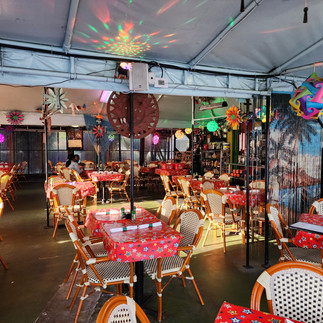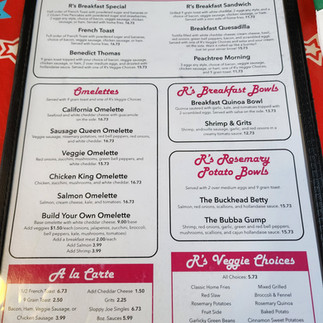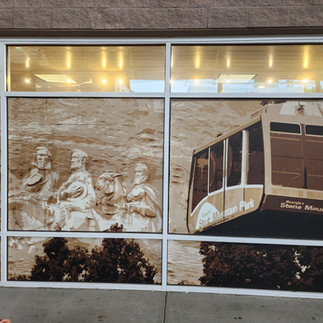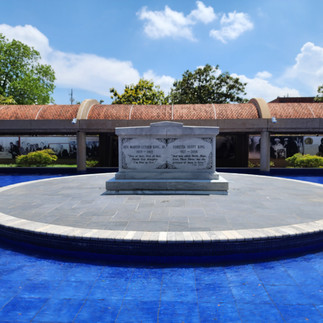Reflections in Atlanta
- Cathy Lou Theresa
- Dec 6, 2023
- 15 min read
Arrival- First Day

This was our first “Go Wild” Frontier flight. Frontier Airlines has a pass on sale that you can use to fly all you can fly for one year. We purchased for $599. We didn’t even think twice, we just bought it. Flights are not always plentiful and not always available from every airport, and sometimes there are really long layovers, but getting a direct ticket and flying from Philadelphia to Atlanta was easy.

Except it was another early morning flight. Up at 3am to be on our flight at 6am. So, as soon as we land and I had my morning nap on the plane, I was thinking that it was super cool that I was in Atlanta, but, seriously, “Where’s the coffee?” There wasn’t an appetizing coffee place in the airport in Atlanta that didn’t have a long line, so we held off and took the train to the Peachtree Station, which was about 25 minutes and headed to the Corner Bakery.

We both ordered the Power Breakfast Bowl and coffee to fuel our adventure. While we ate and enjoyed our coffee, we read up on the history of Atlanta. As we were learning around the country, the railroad is instrumental in the founding of so many cities. The Civil War is also a big part of history of certain cities in the U.S. We were eager to learn more.

We weren’t picking up our rental car until later in the day. No sense in dealing with parking. So, we took our backpacks and headed to the Aquarium. The aquarium seemed the best place to spend a long day on little sleep. Who doesn’t love looking at fishes? It’s so relaxing. So, we meandered through the aquarium with our backpacks. While we were there we got roped into doing one of those Time Share presentations with the lure of 7 days free at a Wyndham Resort somewhere. We will let you know if it ended up being worth it.
Next we headed to the Civil Rights Museum. The exhibits included such important milestones such as the March on Washington led by Martin Luther King, Jr, who’s home was in Atlanta, the bombing of the 16th Baptist Church in Birmingham, Alabama in 1963 where 4 young African American girls were killed, the march in Selma on the Edmund Pettus Bridge that resulted in marchers being brutally beaten by law enforcement officers and came to be known as “Bloody Sunday”, and the assassination and funeral of Martin Luther King, Jr.
The Edmund Pettus Bridge was named for a confederate, Edmund Pettus, and there was talk of renaming the bridge for someone more representative of the Civil Rights Movement, but it seems that the bridge, as named, represents a civil rights event far bigger than the man’s name today. The name of the bridge, and its events has overshadowed the name of the man. The confluence of confederate history and African American History and Civil Rights history is often at odds with each other in representation, as we would discover more in Atlanta.
Then off we went to retrieve our rental car through Turo. We took the subway from Peachtree Station to Atlantic Station. The Turo host lived across from a hotel so we met him there and then we drove off to meet Chris’s friend from college, a Penn State fraternity brother. We met at Rose’s Bistro and Champagne Bar, which was a great little place filled with flowers. We had the spicy mango shrimp and it was really out of this world. We were having such a good time that we forgot to take a picture, but you will have to just take our word for it. I think we knew then that Atlanta was going to be a foodie heaven, and we wordlessly abandoned the idea of our usual method of stocking up on food in the grocery stores and storing it in a cooler. We sat outside on the patio and drank wine with dinner. The restaurant is located in Atlantic Station, which is a couple miles north of the center of Atlanta. We took a walk around after dinner. They had some great gathering places for families and couples. It felt very inclusive, with a giant screen for “Screen on the Green”.
We finally went to our airbnb that we found for $25 a night. It had a bed, a tv and a refrigerator. It was quite the find.
Second Day
The next morning, we went looking for our first breakfast spot. I had read that this colorful, unique place also had healthy food options. Not only was it filled with colorful and unique art, but they had parrots outside to talk to.
They had always been funky, but in 1990, the owners discovered the benefits of fresh juice, so they started serving carrot juice, and soon enough, they were offering fresh produce, organic grains and all kinds of vegetables and superfood. I had the salmon omelet with side order of potatoes and Chris had the breakfast quesadilla. The juice was great, as was the coffee.
We were learning just how big the city of Atlanta is, with 132 square miles. We learned that without geographical boundaries such as mountains or rivers, there was no end to the sprawl. Getting around was not that easy and we were glad for our rental car. The MARTA (Metropolitan Atlanta Rapid Transit Authority) system though, very good, cannot keep up with the sheer size of the city. Furthermore, there was some opposition in the 60’s and 70’s to MARTA, which was rooted, some say, in segregation. Some people had no desire to provide public transportation outside of their immediate communities. Some say that the funding policies involved in that compromise affect Atlanta to this day.

After breakfast we went to the Atlanta History Museum which was located about 10 miles north of the center of Atlanta. The Atlanta History Museum, formerly known as the Atlanta History Center, opened its doors to the public in 1926. It has since grown into one of the largest history museums in the Southeastern United States, offering a comprehensive exploration of Atlanta's past and cultural heritage.


The changing population over the years in Atlanta tells a story, hidden behind the numbers. How many native Americans were in Georgia in 1733? How many African Americans?

How did the population change over time?
The displays on desegregation were organized to make you feel like you were there and got you thinking about what you might do if you were there.
The displays on the Civil War told a different story than the usual stories. I thought the displays did a great job explaining why the civil war happened in balance, how it proceeded and what the aims were. Why was the Civil War fought? For independence or or for slavery? Well, both.

The most fascinating part of the Atlanta History Museum was the film on Stone Mountain. Stone Mountain is a geological feature near Atlanta, known for its massive granite outcrop and historical significance. Rising 825 feet above the surrounding landscape, it is one of the world's largest exposed granite formations. Located within Stone Mountain Park, the site is home to the Confederate Memorial Carving, a controversial monument depicting Jefferson Davis, Robert E. Lee, and Thomas "Stonewall" Jackson. The park offers various outdoor activities like hiking, the Summit Skyride, fishing, boating, and camping.
I was watching the film while Chris was still meandering around the museum. We move at different rates through a museum. We usually end up seeing and noticing the same things, but I would have to admit that he is more thorough. I left the theater after seeing the film and found Chris and I said, “We have to go to Stone Mountain”, and he said, “I know, we will.” We had known about Stone Mountain, but we had no idea of the depth of controversy, history and hiking to a beautiful sunset! So I said, “No, I mean, now.” I found it a really interesting controversy because of the confluence of true art, history, and politics.
So, Chris went to to see the film and then he agreed, let's go. So, we went right away to Stone Mountain. We wanted to go on the sky ride up the mountain because we didn’t know what the hike would be like, but when we got there it was raining and the ride was temporarily closed, so we went in search of dinner.
We made it to to the Stone Mountain Golf Club for dinner just in the nick of time. Chris was taking pictures outside while I went inside and they said that they were just about to lock the doors. We almost locked the doors on Chris because I was hungry and he was still taking pictures outside! We ordered arugula salads, mine with salmon and Chris’s with chicken, and the service could not have been better. They were so friendly and helpful with our orders even though it was almost closing time.
We went back to the sky ride and it was open! The sky ride was an amazing ride with great views. We had an interesting side view of the monument that shows just how big it is. The top had such a masterpiece of a sunset that I could not believe our luck. I had a feeling that it wasn’t going to be our last sunset here. We had missed the sky ride down, so we started the walk down. It took us about 45 minutes and it really wasn’t that hard at all. Each step gave us views to sustain our way down.
When we got to the bottom, we weren’t exactly near our car, so we had to take a fairly long walk back, but we walked through Latinfest with the village lit up. They had live music, latin artists, arts and crafts and family friendly activities. No battery, no pictures! There was a lot more to explore at Stone Mountain.
Third Day
Chris was inspired, so he got up really early, drove to Stone Mountain and walked up the mountain which took a little longer to go up than down because of the incline, maybe an hour and 15. The weather was pretty iffy on the way up and he was hoping it wasn’t going to rain on him. Up on top, the view was still spectacular even with the clouds. He was looking a bit ragged, but he had his coffee! By the time he got back to me, I was up, I had a little bit of breakfast in our room. We had gone to the grocery store the night before and stocked the little refrigerator with snacks. So I was ready to go.

For this morning’s foodie adventure, we went to the Flying Biscuit. I had recently downloaded the new ChatGPT app, Ask Al, and I love asking where to get good, healthy breakfasts, as well as cool spots for sunset or spots with live music. Atlanta would not have been the same without Al.
The Flying Biscuit is in Midtown and advertises Southern Cooking, but it also had vegetarian and vegan items. Obviously, (if you have read any of our blogs) we are not vegetarian or vegan, but we are trying to eat more fruits and vegetables for health reasons and I figured that they would have that. I had two eggs, avocado toast with tomatoes and fresh fruit.
After breakfast we had to get to our Club Wyndham tour. When we complete this tour, we get a week in a Wyndham Resort for 7 days for 75$. I’ll let you know how that turns out, but for now, we had to do this. During the tour, we are asked things like, where do we like to travel to and how much do we spend per night. They pretty much ignore my answers of “everywhere” and about $50-$100 a night. They prefer answers like, “Cancun” and $200 a night. The last time we spent $200 a night was when we were stuck in Maine last year (not a bad place to be “stuck” in in July) because our car broke down and we had to get a hotel room in Augusta. The only other time we spend that much is if we do a night at our favorite ski resort, and that’s really only out of sentimental reasons, since we spent quite a few nights there when we were first dating (and drinking). So, in my opinion, the economics of what they are selling just don’t make sense for us, but we got through the presentation and finally, (finally!) got our 7 day certificate to use at a different time. I was starving (I would do the presentation again, if they fed us something other than chips) so we went to the restaurant right directly under the Wyndham, which was a Margaritaville.
After lunch, we went on the infamous Ferris wheel in Atlanta. Located in Atlanta's Centennial Olympic Park, the Ferris Wheel in Georgia has become a beloved destination since it was built in 2003. Standing tall at 20 stories, it offers panoramic views of the city skyline and has become an iconic symbol of Atlanta's charm with impressive architecture and vibrant lighting.
We walked all over Centennial Park, which is a giant area, of 22 acres. It was created for the 1996 Olympics, and it provides somewhat of a respite from the hustle and bustle of the city with lush greenery and interactive fountains and historical plaques to read, including the terrorist bombing in 1996 that took place in this park and to Richard Jewel who was initially wrongly accused of the bombing, but in actuality saved many lives that night. His story was made into a movie.
Then back we went to Stone Mountain. This time we both made the walk all the way up. This was Chris’s second time of the day making this hike. The hike took about an hour a half, and I did it with a pulled muscle in my back. I stopped and stretched a lot and it wasn’t too hard to do. The sunset on top this night was like a cacophony of color in the sky. We made it down by dark.
I was beginning to ponder the confluence of controversy of the confederate sculpture and the absolute beauty and joy of this place. I almost wished that the sculpture did not exist to mar the beauty. Though, we truly can’t erase the past, but we can see it for what it is and see all of the dimensions of a place. The sculpture itself is remarkably done and almost miraculous in its art, but it’s a reflection of the times and an inaccurate recall of history that it represents. As the video explained in the beginning of the blog the sculpture was completed long, long after the Civil War, so the reasons for its existence lay in the first half or so of the 20th century and less so in the mid 19th century.



Fourth Day
This was our last full day in Atlanta, and we pretty much decided that we have to come back because it wasn’t enough time. This morning we went to the West Egg Cafe which is a southern cooking cafe that has a special coffee menu, so it seemed a great choice. We both had shrimp and grits with a side order of brussel sprouts.
Today we went to the Martin Luther King Jr National Historical Park. We first noticed the International Civil Rights Walk of Fame which honors individuals who have made significant contributions the advancement of Civil Rights where many school children were gathered around. In front of the Visitor Center was a statue of Ghandi that serves as a reminder of the influence of Mahatma Ghandi’s teachings on Dr. King’s philosophy of peaceful protest. Dr. King was particularly interested in the concept of Satyagraha, which emphasized the pursuit of truth and justice through non violent means. Mahatma Gandhi's influence on Martin Luther King Jr. was profound and transformative. Gandhi's principles of nonviolent resistance, civil disobedience, and his emphasis on the moral and spiritual dimensions of activism deeply shaped King's philosophy and approach to the Civil Rights Movement. King drew inspiration from his successful campaigns in India, adapting and applying those principles to the American context.
In the visitor center is the Children's Courage Exhibit, a display that highlights the bravery of young activists during the Civil Rights Movement. There is a timeline that chronicles the key events and milestones in his journey from his birth on January 15, 1929, in Atlanta, to his leadership in the Montgomery Bus Boycott and the March on Washington. The timeline showcases his efforts in the pursuit of civil rights and racial equality. The Freedom Road Walkway in the visitor Center is a symbolic representation of the journey towards freedom and equality in the context of the Civil Rights Movement in the United States. It honors the collective efforts of individuals who fought for civil rights and paved the way for progress. There is a certain joyful solemnity in standing among the walkers.
The park also pays tribute to Coretta Scott King, Dr. King's wife, who was an influential figure in her own right. Coretta Scott King continued her husband's work after his assassination in 1968, advocating for social justice, women's rights, and nonviolence.
The Martin Luther King Jr. National Historic Site in Atlanta is home to the historic Ebenezer Baptist Church, where Dr. King served as co-pastor, and the burial site of Dr. Martin Luther King Jr. and his wife, Coretta Scott King. The burial site is marked by a peaceful and reflective area known as the Reflecting Pool. The pool is surrounded by beautifully landscaped gardens and features a black granite marker that bears the inscription "Martin Luther King Jr. / 1929-1968" along with a quote from his famous "I Have a Dream" speech.
The historic fire station #6 served the Sweet Auburn neighborhood, which was Dr. King's childhood home and the heart of Atlanta's African American community. Today, the fire station houses an exhibition that explores the history and culture of the area. I was really impressed with the historic sites in Atlanta that told the story of the South without either apologetics or apology. I feel like I came away with an understanding of the South that I didn’t before and a sense that maybe the universe does, in fact, bend towards justice.
Next we headed over to the Jimmy Carter Center, Library and Museum. It was located on the Freedom Parkway which was built in the 80’s as part of an urban renewal project. The museum was built in 1986 and showcases the life and work of Jimmy Carter with artifacts, timelines and even a replica of the Oval office. As you walk through the museum, you get a sense that you are walking through his life, from life on a farm in Georgia to the growth of his family to his presidency and all of it’s complications, to his post presidential life advocating for diplomacy and human rights.
By then we were right around the corner from the Ponce De Leon Market. The Ponce De Leon marketplace is a thriving hub of diverse vendors and activities. This marketplace, which opened in 2014 offers a variety of retail and restaurants. It is housed in the historic Sears, Roebuck & Co. building, which originally dates back to 1926. In its early years, the building served as both a retail store and regional headquarters for Sears. The building is gorgeous with big, gigantic elevators which all lends to a historic feel. We had dinner at a Szechuan restaurant bar, called Jia situated along the mall walkway where we had chicken and rice.
Next, we headed upstairs in the gigantic elevators where the rooftop was a spectacular area of activity and food and drink options. Chris had a zoom meeting, so I got a drink and meandered the roof top and took in the view of the city.
When Chris was done with his meeting, we headed outside to the Beltline Trail. The Beltline trail is 22 miles and surrounds the city and is divided into several interconnected sections of diverse sections of the city. You can just hop off at any time on the trail and explore a new neighborhood of the city. We rented a scooter and scootered south and then explored the neighborhood of the Old Fourth Ward and back up to the Market.
Last Day
For our last breakfast in Atlanta, we went to Bantam and Biddy. We both had the Protein Scramble with chicken and fruit.
We then took a quick run through of the Botanical Gardens and Chris even took off on a scooter for a little bit. We met a gentleman who was in need of food, so, since we had leftover food and we were getting on the airplane, we gave him our food.

Then we met our Turo host and he took us to the airport. While driving, we told him all about our trip and interestingly the conversation turned to Stone Mountain since it was our favorite place in Atlanta, and one of our top favorite experiences, I think, anywhere. What is different about this confederate art than the confederate statues that have been the center of controversy, is that the engraving is most certainly a unique piece of art. It also has a personal aspect to it that confederate statues just don’t have. However, this engraving is representative of the “Lost Cause theory”.
The Lost Cause theory emerged after the American Civil War and sought to reinterpret the war's causes and consequences in a way that portrayed the Confederacy in a positive light. It downplayed slavery as the central issue, instead emphasizing states' rights and cultural differences. Confederate leaders were portrayed as honorable heroes, while Reconstruction was depicted as a corrupt and oppressive period. Critics argue that the Lost Cause theory distorted history to justify the Confederacy and perpetuate white supremacy.
Atlantans, on the whole, do not seem bothered by the controversy. It seems to just be within a particular conversation held between people who are connected to it or connected to the task of representing history. I think the park is just so gorgeous and fun that the engraving is not given much thought, even though the issue of representing history is very much still alive and debated.



It was clear to me though, at many of the historical sites in Atlanta, that Atlanta knows how to write about history respectfully without white washing. There seems to be a few ideas about how to handle the controversy of the engraving. Taking it down, certainly could be done, but not without damage to the natural mountain itself. That seems implausible to consider. They could change the engraving, but that seems unlikely and kind of lame. I guess I’m partial to the idea of some interpretive art somewhere in the park that presents the side of bondage, and suffering and the slowly evolving economic system that led so many to ruin in juxtaposition to the “lost cause” narrative, that seems to have led to its own discord in the country.


Off to home...


























































































































































































































































































Comments